
The 500th Air Expeditionary Group is a provisional United States Air Force unit. Its last known assignment was at Christchurch, New Zealand, where it was activated for the summer 2005–2006 season.

The 504th Bombardment Group was a World War II United States Army Air Forces combat organization.

The 29th Flying Training Wing is an inactive United States Air Force unit last based at Craig Air Force Base, Alabama. It was inactivated when Craig was closed when the Air Force reduced its pilot training program after the Vietnam War.

The 502d Bombardment Group was a World War II Army Air Forces (AAF) strategic bombardment organization. The unit was one of the last few combat groups formed by the AAF, activating on 1 June 1944. After nearly a year training with Boeing B-29 Superfortress, it moved to Guam in April 1945. It flew its first combat mission on 30 June 1945 and its first strike on the Japanese home islands in July. It was awarded the Distinguished Unit Citation for attacks on the Japanese oil industry between 5 August and 15 August 1945. After V-J Day it flew show of force missions and evacuated prisoners of war. It remained in the Pacific until it was inactivated on 15 April 1946.
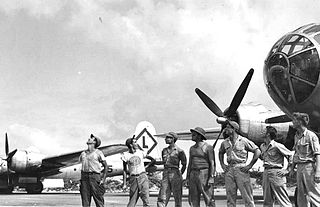
The 331st Bombardment Group is an inactive United States Air Force unit. It was last assigned to the 315th Bombardment Wing, being stationed at Northwest Field, Guam. It was inactivated on 15 April 1946.

The 346th Bombardment Group is a former United States Army Air Forces unit. It was last assigned to the 316th Bombardment Wing at Kadena Airfield, Okinawa, where it was inactivated on 30 June 1946. The group was originally a heavy bomber training unit, but was inactivated in a general reorganization of Army Air Forces training units in 1944. It was reorganized as a Boeing B-29 Superfortress group later that year. It moved to Okinawa in 1945, but arrived too late to participate in combat.
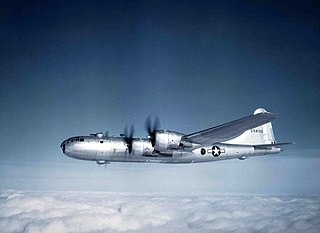
The 382d Bombardment Group is a former United States Army Air Forces unit. It was last stationed at Camp Anza, California, where it was inactivated on 4 January 1946. The group was active from 1942 to 1944 as a heavy bomber training unit. It was reorganized as a very heavy bomber unit and trained for deployment overseas. However, it arrived at its overseas station too late to see combat, and returned to the United States, where it was inactivated.

The 383d Bombardment Group is a former United States Army Air Forces unit. It was last stationed at Camp Anza, California, where it was inactivated on 4 January 1946. The group was active from 1942 to 1944 as a heavy bomber training unit. It was reorganized as a very heavy bomber unit and trained for deployment overseas. However, it arrived at its overseas station too late to see combat, and returned to the United States, where it was inactivated.

The 435th Bombardment Squadron, also known as the "Kangaroo" Squadron, is an inactive United States Air Force unit. It was formed in Australia in March 1942 as the 40th Reconnaissance Squadron and participated in combat in the Southwest Pacific Theater until November, when it was withdrawn from combat and returned to the United States, where it acted as a Replacement Training Unit until October 1943, when its personnel and equipment were withdrawn.
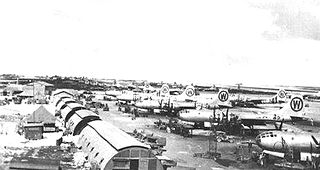
The 505th Bombardment Group is an inactive United States Air Force unit. Its last assignment was with Thirteenth Air Force, stationed at Clark Field, Philippines. It was inactivated on 30 June 1946.

The 770th Bombardment Squadron is a former United States Army Air Forces unit. It was last assigned to the 462d Bombardment Group at MacDill Field, Florida, where it was inactivated on 31 March 1946. The squadron was first activated in 1943, and became one of the earliest Boeing B-29 Superfortress units. It moved to the China Burma India Theater in April 1944 and participated in the first attack on the Japanese Home Islands since the 1942 Doolittle Raid in June 1944. It earned its three Distinguished Unit Citations. The squadron moved to Tinian with the rest of the 58th Bombardment Wing in April 1945 and continued its participation in the strategic bombing campaign against Japan until V-J Day. In November 1945, it returned to the United States, where it was inactivated.
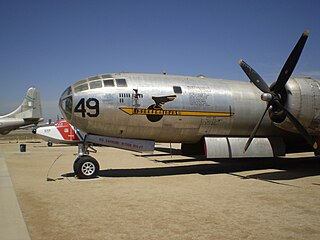
The 883d Bombardment Squadron is a former United States Army Air Forces unit. It was organized in November 1943 and, after training in the United States, deployed to the Pacific Ocean Theater of World War II, where it participated in the strategic bombing campaign against Japan. It earned two Distinguished Unit Citations before the end of the war. It returned to the United States in the fall of 1945 and was inactivated at March Field, California in January 1946.

The 880th Bombardment Squadron is a former United States Army Air Forces unit. It was an early Boeing B-29 Superfortress unit, but was inactivated in the spring of 1944 when the Army Air Forces reorganized its very heavy bomber units. It was reactivated in August 1944 and deployed to the Pacific in 1945, but arrived too late to see combat. The squadron returned to the United States in December and was inactivated.

The 876th Bombardment Squadron is a former United States Army Air Forces unit. It was an early Boeing B-29 Superfortress unit, but was inactivated in the spring of 1944 when the Army Air Forces reorganized its very heavy bomber units. It was reactivated in August 1944 and deployed to the Pacific in 1945, but arrived too late to see combat. It returned to the United States in December and was inactivated.
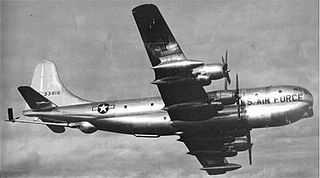
The 303rd Air Refueling Squadron is an inactive United States Air Force unit. It was last assigned to the 499th Air Refueling Wing at Kindley AFB, Bermuda, where it was inactivated on 15 June 1963.

The 461st Bombardment Squadron is an inactive United States Air Force unit. Its last assignment was with 346th Bombardment Group at Kadena Airfield, Okinawa, where it was inactivated on 30 June 1946. From 1942 the squadron served as a replacement training unit for heavy bomber aircrews. It was inactivated in the spring of 1944 in a general reorganization of Army Air Forces training units. The squadron was activated again in 1944 as a Boeing B-29 Superfortress unit. Although it deployed to the Pacific, it arrived too late to see combat service.
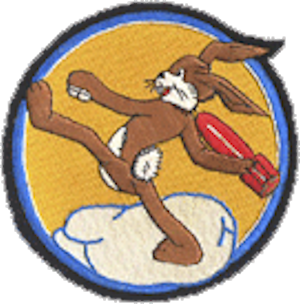
The 463d Bombardment Squadron is an inactive United States Air Force unit. Its last assignment was with 346th Bombardment Group at Kadena Airfield, Okinawa, where it was inactivated on 30 June 1946. From 1942 the squadron served as a replacement training unit for heavy bomber aircrews. It was inactivated in the spring of 1944 in a general reorganization of Army Air Forces training units. The squadron was activated again in 1944 as a Boeing B-29 Superfortress unit. Although it deployed to the Pacific, it arrived too late to see combat service.

The 872nd Bombardment Squadron is the former name of the 872nd Air Expeditionary Squadron, a provisional unit of the United States Air Force. It is assigned to United States Air Forces Europe to activate or inactivate as needed.

The 464th Bombardment Squadron is an inactive United States Air Force unit. Its last assignment was with 382d Bombardment Group at Camp Anza, California, where it was inactivated on 4 January 1946. From 1942 the squadron served as a replacement training unit for heavy bomber aircrews. It was inactivated in the spring of 1944 in a general reorganization of Army Air Forces training units. The squadron was activated again in 1944 as a Boeing B-29 Superfortress unit.

The 333d Special Operations Wing is an inactive United States Air Force unit. It was active from July 1968 through March 1970 at Pleiku Air Base, South Vietnam. In 1985, the wing was consolidated with the 333d Bombardment Group as the 333d Special Operations Wing.

















